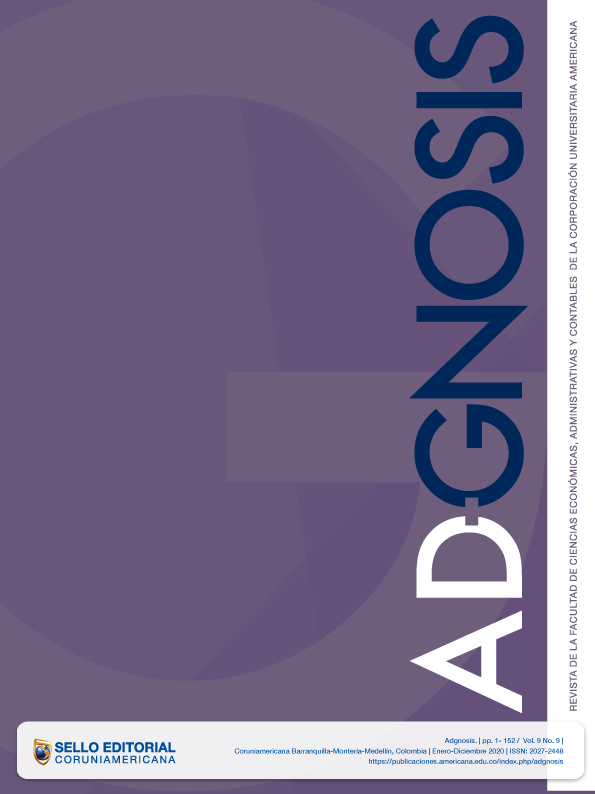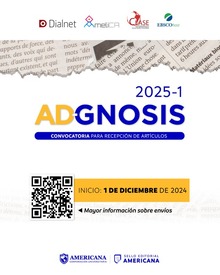Dynamic Capabilities: Theoretical Reflection from the Strategy Field
DOI:
https://doi.org/10.21803/adgnosis.9.9.434Keywords:
Capabilities, Resources, Competitive advantage, Organizational capabilitiesAbstract
Dynamic capabilities are the subject of study in the field of strategy. Its construct, although conceived at the beginning of the 20th century, has only been developed in depth since the 1990s. Throughout the literature on the subject, various definitions can be found, mainly based on three approaches: innovation, contingent and capability building. On the other hand, dynamic capabilities have been finding converging points in their respective perspectives, especially in two key aspects: the first of these is that companies are required to continuously develop the capacity to adapt, and the second is that investing in their construction only makes rational sense if it is done from the perspective of the exploration of new knowledge that allows the continuous construction of new organizational capabilities. In a world of rapid technological change and changes in consumption patterns, dynamic capabilities emerge as a criterion or construct within the field of strategy to try to explain how to create and make competitive advantage sustainable.
Downloads
References
Amit, R.; Schoemaker, P.J. (1993). “Strategic Assets and Organizational Rents”, Strategic Management Journal, vol. 14, nº 1, pp. 33-46.
Barney, J. (1991). Firm Resources and Sustained Competitive Advantage. Journal of Management, 17, 99-120
Collins, D.J. (1994). "Research Note: How Valuable are Organizational Capabilities?" Strategic Management Journal, vol. 15, Winter Special Issue, pp. 143-152.
Evans Philip (1999). Libro Blow to Bits: How the New Economics of Information Transform Strategy. The Boston Consulting Group.
Grant, R.M (1991). The Resource-Based Theory of Competitive Advantage: Impications for Strategy Formulation. California Management Review, Sprin, pp. 114-135
Grant, Robert, M. (1996).Toward a Knowledge Based Theory of the FirmStrategic Management Journal (Washington DC: John Wiley and son) 17 (Winter Special Issue): 109-122.
Hall, R. (1993). “A Framework Linking Intangible Resources and Capabilities to Sustainable Competitive Advantage”, Strategic Management Journal, vol. 14, nº 8, pp. 607-618.
Henderson, R.; Cockburn, I. (1994). "Measuring Competence? Exploring Firm Effects in Pharmaceutical Research”, Strategic Management Journal, vol. 15, Winter Special Issue, pp. 63-84.
Klepper, S.; Simons, K.L. (2000). “Dominance by Birthright: Entry of Prior Radio Producers and Competitive Ramifications in the U.S. Television Receiver Industry”. Strategic Management Journal, vol. 21, nº 10/11, pp. 997-1016.
Laloux Frederic (2015) Reinventar las Organizaciones. Primera edición. Editorial ARPA
Lewis Carroll. “Alicia a Través del Espejo”. Capitulo Jardín de las Flores Vivas. Secuela del cuento Alicia en el País de las Maravillas
Mahoney, J. & Pandian, J.R (1992). The Resource-Based View Within the Conversation of Strategic Management. Strategic Management, Journal. 13, pp. 363-380
Nelson, R.R. (1991). “Why Do Firms Differ, and How Does it Matter?” Strategic Management Journal, vol. 12, pp. 61-74.
Penrose, E. (1958). The Theory of Growth of the Firm. Oxford
Peteraf, Margaret (1993). The Cornerstones of Competitive Advantage: A Resources-Based View. Strategic Management Journal. 14, pp. 179-191
Peterson, A. J., & Sánchez Roca, D. (2016). Percepción del empleador: competencias del egresado de Enfermería de la Universidad Popular del Cesar. Advocatus, (26), 227–237. https://doi.org/10.18041/0124-0102/advocatus.26.944
Prahalad, C. K. y M. S. Krishnan (2008): The new age of innovation: driving co-created value through global networks. Nueva York: McGraw-Hill.
Rindova, V.P.; Kotha, S. (2001). “Continuous ‘Morphing’: Competing Through Dynamic Capabilities, Form and Function”. Academy of Management Journal, vol. 44, nº 6, pp. 1263-1280.
Robledo, F. J. et.al (2015) La Gestión del Conocimiento: Fundamentos Teóricos. Editorial Jorale (México) & Editorial Universidad Autónoma de Baja California (México).
Robledo,F.J; Martinez O., Merlano Andres. Organizational cynicism – An exploration analysis-case: Workers in the city of Cartagena de Indias (Colombia) Vol. 39 (Number 26) Year 2018 • Page 27
Simon, H.A. (1991). “Bounded Rationality and Organizational Learning”, Organization Science, vol. 2, nº 1, pp. 125-134.
Teece, D.J.; Pisano, G. (1994). “The Dynamic Capabilities of Firms: An Introduction, Industrial and Corporate Change, vol. 3, nº 3, pp. 537-556.
Teece, D.J.; Pisano, G.; Shuen, A. (1997). “Dynamic Capabilities and Strategic Management”. Strategic Management Journal, vol. 18, nº 7, pp. 509-533.
Wang, C.L.; Ahmed, P.K. (2007). “Dynamic Capabilities: A Review and Research Agenda”. International Journal of Management Reviews, vol. 9, nº 1, pp. 31-51.
Zajac, E.J.; Kraats, M.S.; Bresser, R.F.K. (2000). “Modeling the Dynamics of Strategic Fit: A Normative Approach to Strategic Change”, Strategic Management Journal, vol. 21, nº 4, pp. 429-453.
Downloads
Published
Issue
Section
License
Copyright (c) 2020 ADGNOSIS

This work is licensed under a Creative Commons Attribution-NonCommercial-NoDerivatives 4.0 International License.






